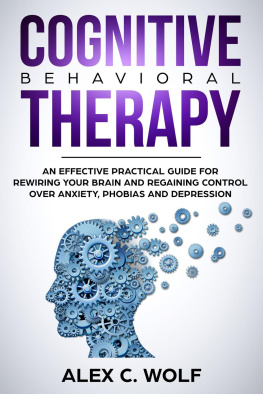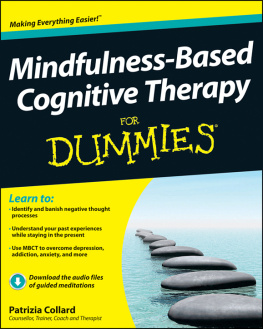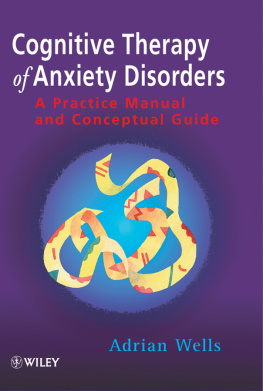Cognitive Behavioral Therapy
The Basics and Beyond of CBT and Psychotherapy
Rebeca Franks
JB Publishing Co
Cognitive Behavioral Therapy Copyright 2015 by Rebeca Franks.
All rights reserved. Printed in the United States of America. No part of this book may be used or reproduced in any manner whatsoever without written permission except in the case of brief quotations em- bodied in critical articles or reviews.
This book contains material protected under International and Federal Copyright Laws and Treaties. Any unauthorized reprint or use of this material is prohibited. No part of this book may be reproduced or transmitted in any form or by any means, electronic or mechanical, including photocopying, recording, or by any information storage and retrieval system without express written permission from the author / publisher.
Any unauthorized broadcasting; public performance, copying or re-recording will constitute an infringement of copyright.
Permission granted to reproduce for personal and educational use only. Commercial copying, hiring, lending is prohibited.
May be used free of charge. Selling without prior written consent prohibited. Obtain permission before redistributing. In all cases this notice must remain intact.
First Edition: August 2015
Chapter 4: Various Methods of CBT
Chapter One: What is CBT?
T hroughout history, there have been many incredible advances within the discipline of psychology. The way we have come to understand the brain and behavior is truly remarkable and has paved the way for a wide range of therapies. Of course, it wasnt always this way. What many refer to as insane asylums, were the norm for many years.
Patients were exposed to horrendous conditions in order to control their undesirable behaviors. In some cases, holes were drilled into patients heads in order to release evil spirits. It wasnt until the 20th century that psychological breakthroughs were being made. Symptoms of hysteria were eventually treated with hypnosis and various therapies began to take shape.
Freuds psychoanalysis therapy, psychological research, and developing therapy methods gave way to behavioral and cognitive therapy. Originally developed to treat depression, cognitive behavioral therapy (CBT) is one of the few therapies which is scientifically proven to be effective, based on hundreds of clinical trials and practical applications. Basically, CBT is a form of psychotherapy that focuses on changing behaviors by modifying ones beliefs and distorted thoughts .
This therapy focuses on the ways in which we perceive situations, directly affecting our feelings and behaviors. If you have a negative interpretation of an event or situation and it goes unchallenged, then you could potentially experience a continuous cycle of thoughts, feelings, and behaviors that are destructive in nature. For some, this affects them throughout the entirety of their lives. As an example, lets focus on a similar scenario affecting two unique and unrelated individuals.
Both Ann and Bobs father left when they were young. Ann has since moved forward and has a family of her own. Although she thinks of her dad, it hasnt affected her mental well-being. Bob, on the other hand, experienced his father leaving and has since felt as though hes worthless. The absence of his father has significantly hurt his self-esteem and is a contributing factor in his persistent anxiety issues.
Although the situations may be unique in terms of the details, the overall past scenario is the same. Both children were not raised by their father, yet their perspectives differ and reactions highly differ. Ann has a more realistic view of her fathers absence. Her father leaving was not due to anything she did, therefore she has not punished herself for his actions. Bob has internalized his dads absence and blames himself. He has the idea that his dad leaving was because he wasnt good enough, leading to all kinds of emotional and interpersonal difficulties in his present life. Bob may not specifically focus on the absence of his father, however, he has carried those negative views of himself throughout his life. Now, they affect his thinking patterns and behaviors.
This is the basis of CBT, as perceived situations are what influence our emotional well-being. This means that it is not necessarily a situation that directly affects how we feel emotionally, rather our thoughts and feelings towards that situation. Ann and Bob experienced the same type of trauma, yet Ann perceived the incident for what it was. However, Bob felt differently and blamed himself. Now he doesnt apply for jobs he wants because he doesnt think hes good enough. This type of thinking patterns is damaging and without cognitive and behavioral interventions, this cycle will continue to control ones thoughts and behaviors.
CBT is all about learning how to stop a cycle of negative thinking and destructive behaviors. By identifying these negative thinking patterns and resulting behaviors, you can change the way you think and behave in the future. As its name states, there are both cognitive and behavioral aspects to this therapy. Cognition focuses on the thoughts that lead to emotional and physical distress. Behaviors, on the other hand, are what worsen and prolong ones negative way of thinking. Its a vicious cycle which is why both aspects need to be addressed. The way you think and behave are not independent of one another. If you change your perspective regarding a specific situation, you could also change your behavior.
As mentioned, the cognitive aspect relates to thinking and one's beliefs. Through the cognitive aspect of therapy, patients learn new methods and skills, in order to change their current thinking patterns. For example, a woman may seek therapy for depression. She has low self-esteem and often expresses that she's worthless. Through cognitive therapy, the client would learn to interpret her automatic thought of 'being worthless' and replace it with more positive thoughts, such as 'I have value.' Any thoughts that are contributing to her low self-esteem would be addressed.
Behavioral is, of course, what we do. When a client takes part in cognitive behavioral therapy, they will address unhealthy and problematic behaviors, replacing them with healthier responses. This aspect of therapy is concerned with practical everyday situations based on what's learned in therapy. For example, a man may be seeking CBT while recovering from alcohol addiction. Together, the therapist and client would develop strategies to overcome impulses that may cause him to drink, based on his identified triggers. The client would learn new coping skills which would be practiced and strengthened. Whether it may be avoiding certain social situations or substituting drinking for a less harmful behavior, the implied coping skills would be based on the individual's personal situation and condition.
Lastly, some therapists are beginning to incorporate some emotional strategies. Working with emotion has been a weakness within CBT in the past, but is now used by some therapists to help clients become more calm, relaxed, and de-stressed. By implementing emotional strategies, the mind can stay more relaxed and is more receptive to therapy. Depending on the scenario, client's may benefit from mindfulness, acceptance and compassion-based techniques, and/or imagery.
A key characteristic of CBT is that its fairly short-lived. This is a great advantage in terms of recovery. Not only do clients recover more rapidly, but theyre able to maintain and manage their recovery long-term. It was originally designed to be a quick and practical treatment option, providing patients with long-term skills to support their health. When taking part in CBT, patients focus on the present moment. Clients are asked to address the issues that create challenges in their day-to-day life. This helps individuals reflect, so that they can properly interpret the world around them and how it affects their thoughts and behaviors.
Next page











